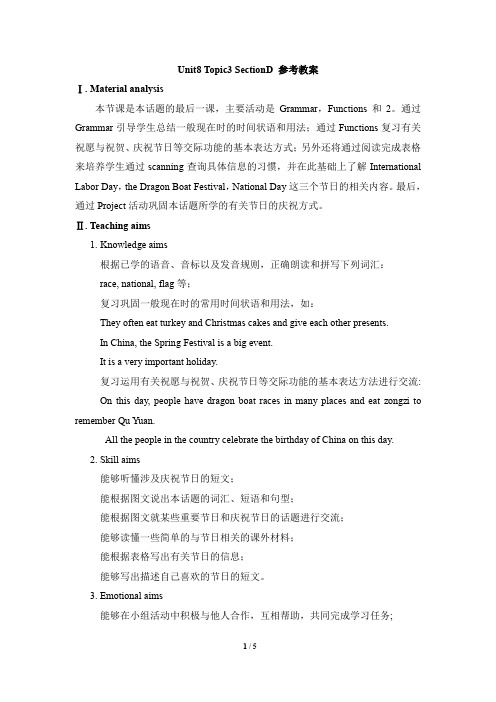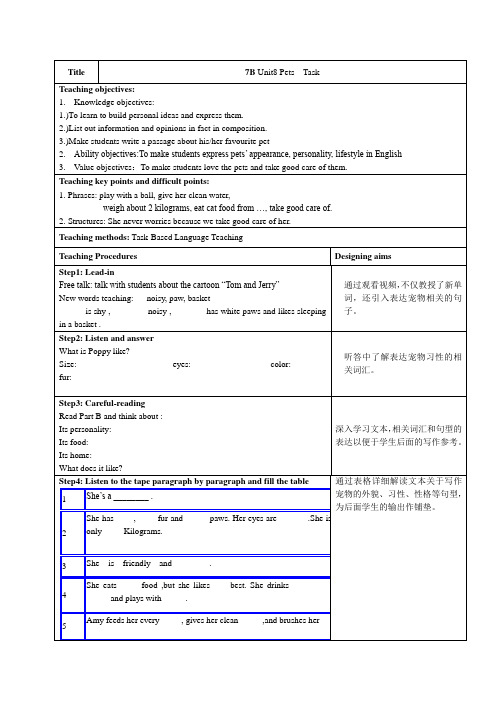7b unit8说课稿
- 格式:doc
- 大小:38.50 KB
- 文档页数:8


江苏译林版7BUnit8教案一、教学目标1、知识目标学生能够掌握本单元的重点词汇,如:pet, goldfish, mouse, rabbit 等。
学生能够理解并运用本单元的重点句型,如:I love my pet It's very friendly 等。
2、技能目标能够听懂关于宠物的简单对话,并获取关键信息。
能够用英语简单描述自己喜欢的宠物。
3、情感目标培养学生对动物的关爱之情,增强保护动物的意识。
二、教学重难点1、教学重点重点词汇的记忆和运用。
重点句型的理解和表达。
2、教学难点如何引导学生用英语准确、流畅地描述宠物的特点。
三、教学方法1、情景教学法通过创设与宠物相关的情景,让学生在真实的语境中学习和运用语言。
2、任务驱动法布置各种任务,如小组讨论、角色扮演等,让学生在完成任务的过程中提高语言能力。
3、游戏教学法通过有趣的游戏,激发学生的学习兴趣,巩固所学知识。
四、教学过程1、导入(Leadin)展示一些可爱的宠物图片,如小狗、小猫、小兔子等,问学生:Do you like pets? 引导学生回答 Yes 或 No,并简单说一说原因。
2、词汇学习(Vocabulary learning)利用图片、实物或动作,依次教授本单元的重点词汇,如 pet, goldfish, mouse, rabbit 等。
让学生跟读单词,然后进行小组或个人的词汇朗读练习,教师及时纠正发音。
3、句型学习(Sentence pattern learning)呈现一些关于宠物的句子,如:I have a dog It's very cute 引导学生理解句子结构和意思。
让学生模仿这些句子,用所学词汇进行造句练习,如:I have a cat It's very friendly4、听力训练(Listening practice)播放课本中的听力材料,让学生认真听,并完成相关的听力练习。
听完后,核对答案,并让学生重复听到的关键句子,以加强听力理解和口语表达。

初一年级下学期英语教案(编号:)主备人:审核人:【课题】7B Unit8《Pets》Comic strip & Welcome to the Unit 【教学目标】1.让学生掌握基本的四会单词、短语和句型。
1.让学生认识几种宠物的名称及其典型特征【教学重、难点】1.学会用本课时的短语或句型介绍宠物。
2.培养学生的爱心,激发学习的兴趣。
【教学方法】Multi-Media【教学过程】Step 1 情景导入Teacher: Do you like animals? What animals do you know more? Do you or your friend have a pet at home? What are they?Step 2 完成教材Comic strip的任务1.让学生认真听录音,回答下列问题。
(1)What does Eddie ask Hobo to do?He asks Hobo to bring him something to eat.(2)Is Hobo happy? Why?No. Because Eddie didn’t say “please”.2.让学生阅读Page 92中的对话,回答下面的问题。
What does Eddie want at first and at last?He wants something to eat at first. At last he wants a new pet.3.再次播放录音,让学生跟读对话,注意语音和语调。
4.组织学生两人一组结对练习。
老师请几组学生上台展示并点评。
Step 3 完成教材Welcome to the unit的任务1.呈现几幅动物的图片,提问学生。
What’s this?Do you like it?Why or why not?2.展示Part A的图片,让学生猜动物的名称,完成Part A的练习,全班核对答案。

Unit8 Topic3 SectionD 参考教案Ⅰ. Material analysis本节课是本话题的最后一课,主要活动是Grammar,Functions和2。
通过Grammar引导学生总结一般现在时的时间状语和用法;通过Functions复习有关祝愿与祝贺、庆祝节日等交际功能的基本表达方式;另外还将通过阅读完成表格来培养学生通过scanning查询具体信息的习惯,并在此基础上了解International Labor Day,the Dragon Boat Festival,National Day这三个节日的相关内容。
最后,通过Project活动巩固本话题所学的有关节日的庆祝方式。
Ⅱ. Teaching aims1.Knowledge aims根据已学的语音、音标以及发音规则,正确朗读和拼写下列词汇:race, national, flag等;复习巩固一般现在时的常用时间状语和用法,如:They often eat turkey and Christmas cakes and give each other presents.In China, the Spring Festival is a big event.It is a very important holiday.复习运用有关祝愿与祝贺、庆祝节日等交际功能的基本表达方法进行交流: On this day, people have dragon boat races in many places and eat zongzi to remember Qu Yuan.All the people in the country celebrate the birthday of China on this day.2. Skill aims能够听懂涉及庆祝节日的短文;能根据图文说出本话题的词汇、短语和句型;能根据图文就某些重要节日和庆祝节日的话题进行交流;能够读懂一些简单的与节日相关的课外材料;能根据表格写出有关节日的信息;能够写出描述自己喜欢的节日的短文。


Unit8 Topic1 SectionD 参考教案Ⅰ. Material analysis本节课是一节复习课,主要活动是Grammar, Functions 和2a。
Grammar 部分主要引导学生总结一般现在时和一般过去时在谓语动词形态上的差异,归纳形容词和副词的构词法。
Functions 部分引导学生复习Sections A~C 所学的谈论季节、天气、气温、不同季节适合做的活动的表达法以及表达问候和建议的句型。
最后,Project 通过和同学分享描述四季的不同方式,培养学生的归纳总结能力。
Ⅱ. Teaching aims1. Knowledge aims根据已学的语音、音标以及发音规则,正确朗读和拼写下列词汇:hat, ourselves, trip, noon.引导学生巩固复习询问和描述不同季节、天气、气温、不同季节适合做的活动的表达方式,如:(1) —What’s the weather like in spring?= How is the weather in spring?—It’s warm. It’s a good time to.../ It’s a good season for.../We can...(2) —Which season do you like best, spring, summer, fall or winter?—I like … best.(3) —Why/Why do you like it?—Because...(4) —What’s the temperature?—The lowest temperature is .../ The highest temperature is …复习规则动词和不规则动词的过去式以及形容词和副词的构词法;引导学生总结一般现在时和一般过去时的区别。
2. Skill aims能够听懂谈论季节和天气状况的对话和短文;能够熟练使用英语询问和描述季节及天气情况;能够在图画的帮助下进行阅读,理解大意,并从阅读材料中获取所需要的信息;能够编写有关季节和天气的短文。
教师学科教案[ 20 – 20 学年度第__学期]任教学科:_____________任教年级:_____________任教老师:_____________xx市实验学校教学内容:牛津7B Unit 8第6课时(Grammar 第2课时)教学目的:1. to tell the differences among “should”, “ought to”, and “must”2. to choose the right way to look after the pets教课类型:New Teaching Lesson教学方法:discussion teaching, demonstration teaching, interactive teachiong, exploring teaching教具准备:a multi-media computer教学重点:the right way to use “should”, “ought to”, and “must”教学过程:Step 1: Revision (3 mins)Revise how to give instructions.Step 2: Presentation (5 mins)①Present “You should play with your pet for some time every day.”② Explain the usage of “should”.Step 3: Practise (2 mins)More exercises to practise “should”.Step 4: Presentation/ Practise (20 mins)The same way to present “should not”, “ought (not) to”, “must (not)”.Step 5: Exercises (5 mins)Look at the notes and complete the sentences using “must (not), should (not)and ought (not) to”.Step 6: Discussion (5 mins)Divide the students into 4 groups and find out as many ways as possible tolook after the pets.Step 7: Exercises (5 mins)Put the words in the right order, then choose the correct numbers.Step 8: HomeworkChoose your favourite pet and write a passage to tell your friends how to lookafter it.板书设计:shoud (not) / ought (not) to You should/ ought to play with your pet for some time every day.You should not/ ought not to feed your dog at the table.must (not) You must feed your pet.You must not/ mustn’t feed your pet too much food.教学后记:本课以素质教育为目的,结合教材重点、难点及英语学科特点,利用多媒体辅助教学,从视、听、说等方面使学生得到锻炼,在愉快、轻松的氛围中温故而知新,达到初步运用英语交际的能力。
Teaching PlanTeaching Material: FWE 7 B Unit 8 Grammar(1)Teaching aims:●To use positive and negative imperatives when giving orders and instructions.To organize and understand how to use imperatives appropriately.To use the modals ‘must’, ‘ought to’ and ‘should’ to talk about duties and responsibilities.Teaching Emphases:●To use positive and negative imperatives when giving orders and instructions.To organize and understand how to use imperatives appropriately.To use the modals ‘must’, ‘ought to’ and ‘should’ to talk about duties and responsibilities.Teaching Difficulties:●To organize and understand how to use imperatives appropriately.To use the modals ‘must’, ‘ought to’ and ‘should’ to t alk about duties and responsibilities.Teaching methods and aidsThe eclectic teaching method and the multiple mediaTeaching Steps:Part A1. Talk to students about the purpose of instructions. Give them a few examples using classroomsituations. Write some instructions on the board. Then ask them about the situations when we use them. Ask stronger classes to create a list of different instructions and then write thedifferent situations as titles above it, e.g.,ClassroomSit down.Open the door.Be quiet.Stop talking.Work with a partner.Please close the window.Fire drillWalk quietly.Don’t run.Don’t take the lift.Take the stairs.Line up.Go to the playground.Leave your bags.On the busDon’t push.For weaker classes, jumble the sentences up and ask students to group them under the correct situations.2.Let students talk about how to look after a rabbit?3.Imperative sentences do not normally include a subject, because the subject ‘you’ is implied. However, a noun or pronoun can sometimes be used to identify the person receiving an order or instruction, e.g., the speaker wants to attrac t Mary’s attention and so he/she says, ‘Mary, don’t push.’ / ‘Don’t push, Mary.’. Make sure students understand the imperative form and avoid the common mistake of placing a pronoun in front of the imperative.3 .Go through the explanations and grammar table on page 94 to clarify the rules for using imperatives when giving positive and negative instructions.4. Ask students to study the pictures in Part A1. Check their understanding of the situations presented in the pictures. For weaker classes, review the verbs in the box before students start working on matching the sentences.5. Ask less able students to work in pairs to select the correct word to fill in each gap, then match the pictures with the instructions. When they have finished, ask them to read each instruction to their partner.6. Explain the rubric in Part A2, making sure students understand the exercise. Students rearrange the words to make positive and negative instructions.7. Ask students to read out the instructions they formed.8.Do some exercises to practice giving instructions.Part B1 Talk about situations involving duty and obligation. Try to link them to the context of the Beijing Sunshine Secondary School students who are talking about looking after pets. It is useful to point out to students that we can use these modals to give instructions.2 Go through the examples on page 95& 96, referring to the degrees of necessity. Explain the use of ‘ought to’ and ‘should’, which have more or less the same meaning. ‘Ought to’ is a bit stronger and tends to be used more widely when talking about laws or regulations imported from the outside, while ‘should’ implies personal opinions and, therefore, is less strong.Ask students for sample sentences and write them on the board.3 Ask through the examples of negative sentences. Write some sample sentences on the board.4. Explain to students that ‘must’ is the strongest word , expressing the sense that something is a absolutely necessary .5. In part B1,the Beijing Sunshine Secondary School students give instructions about looking after pets. Each point of the notes on the left describes the degree of necessity for the instruction next to it on the right.Read the notes to the class . Then divide the class into pairs and ask students to complete the instruction on the right. Encourage students to check the example sentence on pages 95 and 96 to identify the correct modal word to fit each instruction .6. Use class feedback to identify any misunderstanding ,as they involve the use of negative forms.7. Ask students to read the four letters in part B2 carefully. Make sure that they understand the messages well. Ask them remember and to check the words in their dictionaries.8. In Part B3, students can read some of the answers which give advice to the writer of each letter. students check answer s with a partner.9. Divide the class into groups of four .one group comes to the front of the class and each member reads one letter at a time .10. Ask more able students to come up with their own advice to the pet owners .Tell them to choose two things you should (not)ought (not) to do when you own a pet. They then write sentences giving instructions. Ask students to read out their advice to the class.教学后记:这是Grammar的教学,对于语法的学习,学生会感到枯燥但本课学生接受的程度比预想的要好。
Lessons draftGood morning everyone. I am Li Yan . Now I will say section A the first period unit 8 Grade 7 in Go For It. I prepare to divide four parts to talk about this lesson .Part One: Analysis of the Teaching Material(一) STATUS AND FUNCTION1. This is the first period. Students will learn seven names of foods first, which are noodles, beef, mutton, chicken, cabbage, potatoes, and tomatoes. The other activities provide listening and oral practice using the target language: I’d like some noodlesWhat kind of noodles would you like?Beef and tomato noodles, please.This period is in the important position of the teaching material. So if the Ss can learn it well, it will be helpful to make the Ss learn the rest periods of this unit.2. In this lesson students will learn to order food. Such a topic is very interesting and related to their daily life, so it will be helpful to raise the students' learning interests and improve their spoken English.(二)ANALYSIS OF THE STUDENTSThe Ss have learned English for about one year so far. They can understand some words and some simple sentences. The Ss have taken a great interest in English now.(三)TEACHING AIMS AND DEMANDSThe philosophy of the new course emphasizes communication and cooperation in meaningful learning situations. students should be the leading roles of class. As a teacher, we should start from the students’ interest to create real or half-real situations to engage the students to research the knowledge actively by themselves. We must try our best to train students’ practical and creative abilities and also we should help them to form good habits of studying and form good learning strategy. At the same time, we should face every student when we teach, and care about the differences between different students. According to this philosophy and the textbook, I think that the teaching aims of this lesson should beknowledge objects:1. Key vocabulary: I’d = I would, would like, noodle, beef, mutton, chicken, cabbage, potato, special2. Target language: I’d like some noodlesWhat kind of noodles would you like?Beef and tomato noodles, please.Ability objects:1. Train students' listening and speaking skills.2. Enable the students to talk about ordering food.3. T rain students’ communicative competence.Emotion attitude and valueGet the students to learn about noodles are popular with people. They are traditional Chinese food.In order to keep healthy, we should often eat healthy food.Get the students to learn to cook for their parents.TEACHING KEY AND DIFFICULT POINTSAccording to the new course standard and the students’ level of study, I think teaching key points should be some names of foods such as noodles, beef, mutton, chicken, cabbage, potatoes, and tomatoes. Learn how to order food using the target language: I’d like some noodles. What kind of noodles would you like? Beef and tomato noodles, please.Because in this lesson the main task is to get the students to master the new words and use the target language correctly.Difficult pointsa. The structure : I’d likeb. listening and speaking practice.c. Improving the students’ communicative competence.Because this is the main task of English teaching. Teaching the students the studying way is the most important.(五) TEACHING AIDSTape recorderA projectorPart Two: Teaching and learning methodsTeaching methods1 scene teaching methods.The purpose of the language learning is to communicate in real situation. So It’s very important to guide the students how to use the knowledge. In this class. I create several scenes to guide the students to practice the target language to achieve the teaching aims.2 task- based teaching methodI’ll let the Ss g et a better understanding of the key structure of the dialogue. I’ll give the Ss some tasks and arrange three kinds of activities: talking, watching CAI, and acting out 1c.It can change the students’ studying way and train students’ practical and creative skills. When they finish the tasks they will feel more confident.3 Pair workin this way , the students’ cooperation skill will be improved. They will learn from each other and help each other. It can build up understanding and friendship between them.Studying waysNew course emphasizes students’ interests of learning and life experience. It advocate studying way of experience, practice, participation, cooperation and exchange. So in this class. I always get the students to research the knowledge actively by themselves, mainly training thestudents’ practical and creative abilities in class. there are many activities for this purpose. All through the class, such as pair work ,group work, the students are always interested in the activities in real situations.Part three: Teaching ProcedureI’ll finish this lesson in six steps.Step1 Warming-up and lead-inCreate plots and scene. Show a picture on the screen by a projector. Ask the students to look at the picture carefully. Guide them to brainstorm the words about foods they have learned before.Purpose of my designing: I think it is important to form a better English learning surrounding for the Ss and at the same time it is necessary to provide situations to review learned knowledge.Step2. PresentationI’ll use CAI to Teach some new words about food , vegetables and meat . Arrange some situations to help Ss understand .The First scene: A little girl is very hungry. What is she eating now? Help the students to answer," She is eating some noodles". Teach the new word: noodles.The second scene: A girl is very hungry too. what is she eating now? students can answer," She is eating a tomato. "with the help of the picture on the screen. Then teach the new words about vegetables such as cabbage, potato.The third scene: with the help of the pictures, teach the new words about meat, such as beef, mutton and chicken.Finally, Get the students to Practice the new words repeatedly and creatively.Make sure that they can grasp the pronunciation, spelling, meaning and usage. Guide them to finish the task in section A 1a. check the answers. Purpose of my designing: To present the scene by CAI is much easier for the Ss to Enrich their vocabulary,Introduce the new words and language goals in this lesson. CAI can provide a real situation with its pictures and it can also make the relationships between the Ss and the teacher better.Step3. Listening Practicelistening is very important. I’ll mainly talk about this step.First ,point to the pictures in 1a.help the students to understand three specials and talk about them. Then set a time limit of one minute for students to name each special next play the tape recorder. Let the Ss listen and check the noodles they hear.finally check the answers with the whole class. Help them to correct the mistakes.Purpose of my designing: 1 To help Ss remember the new words and learn to use target language correctly.2 Call students ‘ attention to the conversation , Help the students form a good habit in listening.3 This step is employed to make the Ss grasp the target language.Step 4 pair workGet the students to work in pairs to communicate with each other according to the material in 1b using the target language. Ask some pairs to act them out and evaluate together. Then guide the students to create the situations by themselves and make up their own conversations Encourage them to act in different parts.Check them if they have any problems . Pay more attention to some students who are weak in studying, be ready to help. Make sure every student master the knowledge they have learned in this class.Purpose of my designing : This step is employed to make the Ss get the general idea of the conversation as a whole one. At the same time let the Ss have a chance to practice their listening and speaking skills.Task-based” teaching method is used here to develop the Ss’ ability of communication and also their ability of co-operation will be well trained. Tell the Ss we should be polite when we order food and we should eat different food every day . . If the Ss can finish this task well, they will benefit a lot in their spoken English.Step5 Summary and consolidationAsk the students to talk about what they have learned in this class in groups , if they have any problems give them some help, then do some exercises to see whether they have really grasp the knowledge theyshould learn in this class.Purpose of my designing: To check the key vocabulary and the target language Ss have learned in the class.Step6.Homework:(1) Recite the words as many as possible after class.(2)Make a dialogue according to 1b , and write it in the exercise book.(3)learn to cook for their parents.Purpose of my designing: I think homework is so important that the Ss should speak English as much as they can in class or after class. It is necessary for the Ss to do some extensive exercises after class to consolidate the knowledge they learned.Part4 teaching evaluationThe whole class, I use all kinds of ways to evaluate the students in various fields at any time. Guide them to evaluate by themselves and evaluate each other or evaluate with the teacher together.. I mainly encourage them as much as possible. Help them to be more confident and encourage them to take part in the activities in class initiatively. And also I pay more attention to their studying way ,evaluate each student Make sure everyone can participate the class activity and have interest in studying. Through the lesson, all the students have master the knowledge they have learned in this class , and form good learning strategy.。